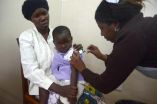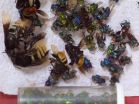(Press-News.org) CHAPEL HILL, N.C. — First results from a large-scale Phase III trial of RTS,S*, published online today in the New England Journal of Medicine (NEJM), show the malaria vaccine candidate to provide young African children with significant protection against clinical and severe malaria with an acceptable safety and tolerability profile. The results were announced today at the Malaria Forum hosted by the Bill & Melinda Gates Foundation in Seattle, Washington.
Half the world's population is at risk of malaria. The disease is responsible for close to 800,000 deaths each year, most of whom are children under five in sub-Saharan Africa
5 to 17 month-old children
The trial, conducted at 11 trial sites in seven countries across sub-Saharan Africa, including a UNC-led site in Lilongwe, Malawi, showed that three doses of RTS,S reduced the risk of children experiencing clinical malaria and severe malaria by 56 percent and 47 percent, respectively. This analysis was performed on data from the first 6,000 children aged 5 to 17 months, over a 12-month period following vaccination. Clinical malaria results in high fevers and chills. It can rapidly develop into severe malaria, typified by serious effects on the blood, brain, or kidneys that can prove fatal. These first Phase III results are in line with those from previous Phase II studies.
The widespread coverage of insecticide-treated bed nets (75 percent) in this study indicated that RTS,S can provide protection in addition to that already offered by existing malaria control interventions.
6 to 12 week-old infants
The trial is ongoing and efficacy and safety results in 6 to 12 week-old infants are expected by the end of 2012. These data will provide an understanding of the efficacy profile of the RTS,S malaria vaccine candidate in this age group, for both clinical and severe malaria.
Combined data in 6 to 12 week-old infants and 5 to 17 month-old children
An analysis of severe malaria episodes so far reported in all 15,460 infants and children enrolled in the trial at 6 weeks to 17 months of age has been performed. This analysis showed 35 percent efficacy over a follow-up period ranging between 0 and 22 months (average 11.5 months).
"The publication of the first results in children aged 5 to 17 months marks an important milestone in the development of RTS,S," said Irving Hoffman, PA, MPH, co-principal investigator at the Lilongwe site. "These results confirm findings from previous Phase II studies and support ongoing efforts to advance the development of this malaria vaccine candidate," said Hoffman, who is also associate professor of medicine in the UNC School of Medicine.
Long-term efficacy
The RTS,S malaria vaccine candidate is still under development. Further information about the longer-term protective effects of the vaccine, 30 months after the third dose, should be available by the end of 2014. This will provide evidence for national public health and regulatory authorities, as well as international public health organizations, to evaluate the benefits and risks of RTS,S.
Safety
The overall incidence of serious adverse events (SAEs)** in this trial was comparable between the RTS,S candidate vaccine (18 percent) recipients and those receiving a control vaccine (22 percent)
Differences in rates of SAEs were observed between the vaccines groups for specific events, such as seizures and meningitis, and were higher in the malaria vaccine group. Seizures were considered to be related to fever and meningitis was considered unlikely to be vaccine-related. These events will continue to be monitored and additional information about the safety profile of the RTS,S malaria vaccine candidate will become available over the next three years.
"Making progress against this disease has been extremely difficult, and sadly, many have resigned themselves to malaria being a fact of life in Africa. This need not be the case," said Francis Martinson, MPH, PhD, co-principal investigator in Lilongwe and country director of UNC Project-Malawi. "Renewed interest in malaria by the international community, and scientific evidence such as that we are reporting today, should bring new hope that malaria can be controlled."
INFORMATION:
The vaccine is being developed in partnership by GSK and the PATH Malaria Vaccine Initiative (MVI), together with prominent African research centers. The partners are all represented on the Clinical Trials Partnership Committee, which is responsible for the conduct of the trial. Major funding for clinical development comes from a grant by the Bill & Melinda Gates Foundation to MVI.
About UNC Project-Malawi
UNC Project-Malawi, a research, clinical care and training center, was established in 1999 in partnership with the Malawi Ministry of Health. The mission of UNC Project-Malawi is to identify innovative, culturally acceptable, and relatively inexpensive methods of reducing the risk of HIV/STI and infectious disease transmission through research; strengthen the local research capacity through training and technology transfers; and improve patient care for the people of Malawi.
The article appears online now at http://www.nejm.org/doi/full/10.1056/NEJMoa1102287.
View the MVI/GSK press release: http://www.malariavaccine.org/FINAL_5-17DataRelease_18-10-11.pdf
*RTS,S contains QS-21 Stimulon® adjuvant licensed from Antigenics Inc, a wholly owned subsidiary of Agenus Inc. (NASDAQ: AGEN), MPL and liposomes.
**A serious adverse event refers to any medical event that occurs during the course of a clinical trial and that results in death, is life threatening, requires inpatient hospitalization, or results in a persistent or significant disability or incapacity needs, regardless of whether the SAE is considered to be caused by the study vaccination. All SAEs are reported to regulatory authorities.
Malaria vaccine candidate, RTS,S reduces the risk of malaria by half in African children
The University of North Carolina at Chapel Hill enrolled 1,600 children at the study site in Lilongwe, Malawi
2011-10-19
ELSE PRESS RELEASES FROM THIS DATE:
Spanish Bullfighting Season Ends with Blinded Matador
2011-10-19
Book Espana has found that there are 693 active matadors in Spain during the 2011 bullfighting season and 2582 aspiring matadors. It appears the amount of bullfighters has increased slightly in 2011 compared to 2010, even if bullfighting in Barcelona has ended recently, mainly due to political reasons.
This year Spain has held 648 traditional bullfights, 130 bullfights with the matador riding on a horseback and 1070 bullfights with younger bulls. It appears about 12 500 bulls has been killed in Spanish bullfights during the 2011 season, while zero matadors has been killed ...
Analyzing the sheep genome for parasite resistance
2011-10-19
Genetic resistance to a parasitic nematode that infects sheep has been discovered by a team of scientists with the U.S. Department of Agriculture (USDA) and the International Livestock Research Institute (ILRI).
The researchers are the first to detect quantitative trait loci (QTL), genetic locations on chromosomes, for resistance to gastrointestinal nematode parasites in a double-backcross population derived from African native sheep. The parasites, common in tropical regions, cause significant economic and production losses in Africa each year. Sheep infected with parasites ...
This month in ecological science
2011-10-19
Evolution of a Stream: Plants and sea-life claim new territory as glaciers retreat in Glacier Bay, Alaska
As tidewater glaciers beat a hasty retreat up Glacier Bay in southeast Alaska, they uncover rocky, barren landscapes and feed cold lakes and streams — new habitat for life's hardy explorers. In the October issue of Ecology, researchers from the Universities of Birmingham, Roehampton and Leeds describe the evolution and assembly of a stream ecosystem in newly de-glaciated terrain, from early insect and crustacean invaders to the arrival of migrating salmon.
Sampling ...
First results from Phase 3 trial show malaria vaccine candidate reduces the risk of malaria
2011-10-19
Contact: Preeti Singh
psingh@burnesscommunications.com
301-280-5722
703-862-2515
Kelsey Mertes
kmertes@path.org
202-540-4422
301-312-7844
PATH Malaria Vaccine Initiative
First results from Phase 3 trial show malaria vaccine candidate reduces the risk of malaria
First results from ongoing Phase III trial show malaria vaccine candidate, RTS,S* reduces the risk of malaria by half in African children aged 5 to 17 months
Seattle, 18 October 2011 — First results from a large-scale Phase III trial of RTS,S, published online today in the New England Journal of Medicine ...
Frames4Less.com Introduces a Simple Way to Buy Custom Frames Online, Launches With an Improved Custom Framing Interface
2011-10-19
The custom framing industry has not yet made its mark on the Internet due to the fact that custom frames are not simple products. Customizable products have just recently begun to penetrate into the world of e-commerce due to advancements in development platforms and connection speeds. Frames4Less.com, a Menache Ecommerce company, aims to bring custom frames within reach of the general population using a fancy new website equipped with a state of the art Custom Framing Interface.
Custom picture frames are expensive and time consuming to order, many don't resort to ...
New study finds gay and bisexual men have varied sexual repertoires
2011-10-19
BLOOMINGTON, Ind. -- A new study by researchers at Indiana University and George Mason University found the sexual repertoire of gay men surprisingly diverse, suggesting that a broader, less disease-focused perspective might be warranted by public health and medical practitioners in addressing the sexual health of gay and bisexual men.
The study, published online ahead of print in the Journal of Sexual Medicine, tapped the largest sample of its kind in the United States to examine the sexual behaviors of gay and bisexual men. In collaboration with the OLB Research Institute ...
2 new bee species are mysterious pieces in the Panama puzzle
2011-10-19
Smithsonian scientists have discovered two new, closely related bee species: one from Coiba Island in Panama and another from northern Colombia. Both descended from of a group of stingless bees that originated in the Amazon and moved into Central America, the ancestors of Mayan honeybees. The presence of one of these new species on Coiba and Rancheria Islands, and its absence from the nearby mainland, is a mystery that will ultimately shed light on Panama's history and abundant biodiversity.
At almost 200 square miles, Coiba Island is the largest offshore island along ...
Penn researchers demonstrate efficacy of non-Hodgkin's lymphoma vaccine
2011-10-19
PHILADELPHIA — An experimental vaccine developed by researchers at the University of Pennsylvania's schools of Medicine and Veterinary Medicine is the first veterinary cancer vaccine of its kind that shows an increase in survival time for dogs with spontaneous non-Hodgkin's lymphoma. The work shows for the first time the feasibility and therapeutic efficacy of this alternative cell-based vaccine, which could be employed in the treatment of a number of different cancer types.
The research was conducted by Nicola Mason, assistant professor of medicine at Penn Vet; Robert ...
Congressman Fortenberry's New GI Bill Promises Veteran Entrepreneurship And Jobs Creation; Bill Authored By Service Disabled Veteran
2011-10-19
On October 13, with little fanfare, Congressman Jeff Fortenberry (NE-1) introduced the Veterans Entrepreneurial Transition (VET) Act of 2011, a landmark new GI Bill that would allow veterans to use their already budgeted educational benefits earned under existing GI Bills, to start up new small businesses.
The VET Act (H.R. 3167) is a GI Bill aimed at addressing the unacceptably high veteran unemployment rate, as well as to help quickly re-build a new generation of veteran-owned small business enterprises across America as the backbone of new job creation.
This GI ...
The political effects of existential fear
2011-10-19
Why did the approval ratings of President George W. Bush— who was perceived as indecisive before September 11, 2001—soar over 90 percent after the terrorist attacks? Because Americans were acutely aware of their own deaths. That is one lesson from the psychological literature on "mortality salience" reviewed in a new article called "The Politics of Mortal Terror." The paper, by psychologists Florette Cohen of the City University of New York's College of Staten Island and Sheldon Solomon of Skidmore College, appears in October's Current Directions in Psychological Science, ...
LAST 30 PRESS RELEASES:
New expert guidance urges caution before surgery for patients with treatment-resistant constipation
Solar hydrogen can now be produced efficiently without the scarce metal platinum
Sleeping in on weekends may help boost teens’ mental health
Study: Teens use cellphones for an hour a day at school
After more than two years of war, Palestinian children are hungry, denied education and “like the living dead”
The untold story of life with Prader-Willi syndrome - according to the siblings who live it
How the parasite that ‘gave up sex’ found more hosts – and why its victory won’t last
When is it time to jump? The boiling frog problem of AI use in physics education
Twitter data reveals partisan divide in understanding why pollen season's getting worse
AI is quick but risky for updating old software
Revolutionizing biosecurity: new multi-omics framework to transform invasive species management
From ancient herb to modern medicine: new review unveils the multi-targeted healing potential of Borago officinalis
Building a global scientific community: Biological Diversity Journal announces dual recruitment of Editorial Board and Youth Editorial Board members
Microbes that break down antibiotics help protect ecosystems under drug pollution
Smart biochar that remembers pollutants offers a new way to clean water and recycle biomass
Rice genes matter more than domestication in shaping plant microbiomes
Ticking time bomb: Some farmers report as many as 70 tick encounters over a 6-month period
Turning garden and crop waste into plastics
Scientists discover ‘platypus galaxies’ in the early universe
Seeing thyroid cancer in a new light: when AI meets label-free imaging in the operating room
Neutrophil-to-lymphocyte ratio may aid risk stratification in depressive disorder
2026 Seismological Society of America Annual Meeting
AI-powered ECG analysis offers promising path for early detection of chronic obstructive pulmonary disease, says Mount Sinai researchers
GIMM uncovers flaws in lab-grown heart cells and paves the way for improved treatments
Cracking the evolutionary code of sleep
Medications could help the aging brain cope with surgery, memory impairment
Back pain linked to worse sleep years later in men over 65, according to study
CDC urges ‘shared decision-making’ on some childhood vaccines; many unclear about what that means
New research finds that an ‘equal treatment’ approach to economic opportunity advertising can backfire
Researchers create shape-shifting, self-navigating microparticles
[Press-News.org] Malaria vaccine candidate, RTS,S reduces the risk of malaria by half in African childrenThe University of North Carolina at Chapel Hill enrolled 1,600 children at the study site in Lilongwe, Malawi



